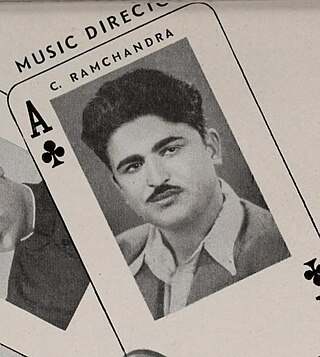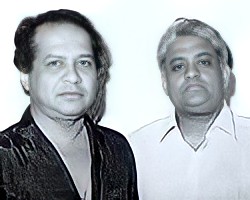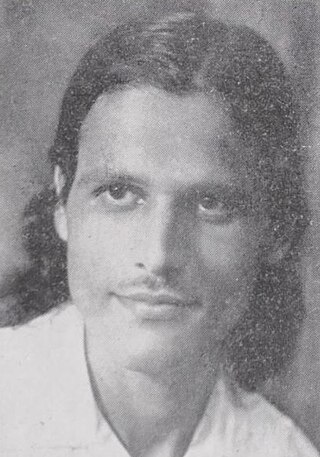
Lata Mangeshkar was an Indian playback singer and occasional music composer. She is considered to be one of the greatest and most influential singers of the Indian subcontinent. Her voice was one of the unifying elements of the people of India, Pakistan, Bangladesh and Nepal. Her contribution to the Indian music industry in a career spanning eight decades gained her honorific titles such as the "Queen of Melody", "Nightingale of India", and "Voice of the Millennium".

Asha Bhosle is an Indian playback singer, entrepreneur, actress and television personality who predominantly works in Indian cinema. Known for her versatility, she has been described in the media as one of the greatest and most influential singers in Hindi cinema. In her career spanning over eight decades she has recorded songs for films and albums in various Indian languages and received several accolades including two National Film Awards, four BFJA Awards, eighteen Maharashtra State Film Awards, nine Filmfare Awards including a Lifetime Achievement Award and a record seven Filmfare Awards for Best Female Playback Singer, in addition to two Grammy nominations. In 2000, she was honoured with the Dadasaheb Phalke Award, India's highest award in the field of cinema. In 2008, she was honoured by the Government of India with the Padma Vibhushan, the second-highest civilian honour of the country. The Guinness Book of World Records acknowledged Bhosle in 2011 as the most recorded artist in music history.

Prabodh Chandra Dey, known by his stage name Manna Dey, was a renowned Indian playback singer, music director, and musician. He had a classical music background, being part of the Bhendibazaar Gharana and receiving training under Ustad Aman Ali Khan. Manna Dey is widely recognized as one of the most versatile and celebrated vocalists in the Hindi film industry, and is often acknowledged for his significant contributions to integrating Indian classical music into Hindi commercial cinema. As a musician, Dey is particularly acclaimed for incorporating Indian classical music elements into a pop musical framework, a contribution that played a pivotal role during the golden era of Hindi cinema.
Jai Hind is a salutation and slogan that originally meant "Victory to Hindustan", and in contemporary colloquial usage often means "Long live India" or "Salute to India". Coined by Champakaraman Pillai and used during India's independence movement from British rule, it emerged as a battle cry and in political speeches.

Ramchandra Narhar Chitalkar, also known as C. Ramchandra or Chitalkar or Anna Sahib, was an Indian music director and playback singer.

Laxmikant–Pyarelal were an Indian composer duo, consisting of Laxmikant Shantaram Kudalkar (1937–1998) and Pyarelal Ramprasad Sharma . They composed music for about 750 Hindi movies from 1963 to 1998, working for almost all notable filmmakers, including Raj Kapoor, Dev Anand, Shakti Samanta, Manmohan Desai, Yash Chopra, K. Balanchander, Boney Kapoor, J. Om Prakash, Raj Khosla, L V Prasad, Subhash Ghai, Mahesh Bhatt, K Viswanath and Manoj Kumar.

Abdul Hayee, popularly known by his pen name (takhallus) Sahir Ludhianvi, was an Indian poet who wrote primarily in Urdu in addition to Hindi. He is regarded as one of the greatest film lyricist and poets of 20th century India.

Kavi Pradeep, was an Indian poet and songwriter who is best known for his patriotic song "Aye Mere Watan Ke Logo" written as a tribute to the soldiers who had died defending the country during the Sino-Indian War.

Ustad Amanat Ali Khan was a Pakistani classical vocalist from the Patiala gharana tradition of music and is widely regarded as one of the finest classical and ghazal singers of all time. Together with his younger brother, Ustad Bade Fateh Ali Khan, he formed a famed singing duo that garnered widespread popularity across the Indian subcontinent. For his contributions to classical music, Amanat Ali was honoured with the highest national literary award of Pakistan – the Pride of Performance – by the President of Pakistan in 1969. Khan was especially noted for khayal, thumri, and ghazal styles of singing and has been described as "the maestro of the Patiala gharana." He stands with singing icons like Mehdi Hassan and Ahmed Rushdi, having left behind a legacy of hundreds of classical and semi-classical songs.

Ramlila Maidan also Ramlila Ground is a large ground located in New Delhi, India, traditionally used for staging the annual Ramlila. It is used for religious festivals, major political rallies and meetings, and entertainment events. It is located near New Delhi Railway Station and Delhi Gate.
Naunihal is a 1967 Indian Hindi-language drama film directed by Raj Marbros starring Sanjeev Kumar, Balraj Sahni and Indrani Mukherjee in lead roles. The film's music was composed by Madan Mohan, with lyrics by Kaifi Azmi, including the song "Meri Aawaz Suno Pyar ka Raaz Suno" sung by Mohammad Rafi. The song is picturized over the funeral procession of Prime Minister of India, Jawahar Lal Nehru.
Usha Timothy is a veteran Bollywood playback singer. Referred to as a "Singer with a difference" She began her career in the film Himalay Ki Godmein (1965). She has sung 5,000 songs in multiple Indian languages such as Hindi, Malayalam, Punjabi, Bhojpuri and Marathi etc.
Pathik Vats also known as U. S. Pathik and Umashankar Pathik is an Indian film maker and writer. He was born in Patauda - a village in Haryana. Later his family moved to Delhi. He graduated from Ramjas College of the University of Delhi.
The Ahir Regiment, also known as the Yadav Regiment, is a proposed infantry regiment of the Indian Army that has been requested by the Yadava community.









